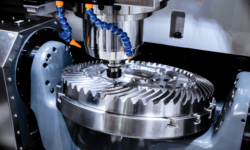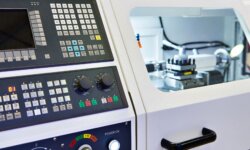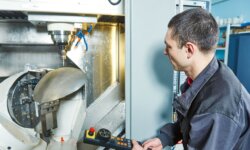In the world of manufacturing, a machining center (MC) serves as the cornerstone for modern industrial applications. But what exactly is a machining center, and how does it contribute to the field of CNC machining?
This comprehensive guide will explore the nuances of machining centers, their functions, types, components, and much more, providing you with in-depth knowledge about this essential tool in the manufacturing process.
What is a Machining Center?
A machining center (MC) is an advanced computer-controlled machine tool that can be used for performing a variety of machining operations and processes. Unlike traditional machines that feature turrets or other mechanisms of manual tool change, an MC consists of an automatic tool-changing mechanism (ATC), allowing for multiple cutting tools to be utilized during the machining process.
This enables quick changes of the cutting tool, thus improving production efficiency and reducing cycle time. The core of an MC lies in its versatility, accuracy, and ability to handle complex operations like milling, turning, boring, drilling, and more.
Who Invented the First Machining Center?
The emergence of the machining center dates back to the early 1950s when John T. Parsons and Frank L. Stulen collaborated to develop the first numerically controlled milling machine.
The idea was further refined by the MIT Servomechanisms Laboratory, laying the foundation for the CNC machining centers that we know today. The invention revolutionized the manufacturing industry, paving the way for automation, precision, and flexibility in metalworking processes.
What are the main components of a machining center?
A machining center comprises numerous intricate components, each serving a specific function in the overall process. We’ll delve into the technical descriptions and functions of these critical components.
Main Spindle Area
The main spindle area is responsible for holding the cutting tools and providing the necessary rotation for machining operations. It houses the motor drives and spindle head, contributing to the accuracy and efficiency of the process. The spindle area plays a pivotal role in achieving desired surface finishes and precision in workpieces.
Taper Feed Mechanism
The taper feed mechanism is an essential part of the machining center that allows for the precise positioning and movement of the cutting tools. It controls the depth and orientation of the tools, ensuring smooth and accurate cuts. This mechanism works in coordination with the servo motor, making it a crucial component in determining the quality of the finished product.
Automatic Tool Changer (ATC) System
The automatic tool changer (ATC) system is a groundbreaking feature in machining centers. It provides quick and efficient tool changes, reducing manual intervention and cycle time. The ATC system includes a tool magazine where different cutting tools are stored, enabling the machine to switch between tools seamlessly. This enhances production efficiency and offers versatility in machining operations.
Tool Magazine
The tool magazine is an integral part of the ATC system. It stores various cutting tools such as end mills, drills, and more, providing a central repository for the tools needed in the machining process. The tool magazine ensures that the correct tool is selected and placed in the spindle, facilitating quick changes and continuous operations.
Automatic Pallet Changer (APC) System
Designed to increase throughput and minimize downtime, the automatic pallet changer (APC) system automates the loading and unloading of workpieces. The APC system consists of multiple pallets that can be preloaded with raw material, allowing for uninterrupted machining. This automation significantly enhances production efficiency, reducing manual handling and errors.
Chip and Coolant Handling System
Machining processes generate chips and require cooling to maintain tool life and part quality. The chip and coolant handling system manages these aspects, collecting chips through chip conveyors and providing the necessary coolant to the cutting area. This system ensures a clean and efficient working environment, contributing to the machine’s longevity and performance.
Overload and Wear Detectors
Machining centers are equipped with overload protection devices and wear detectors to monitor tool wear and machine performance. These sensors detect abnormal conditions, such as tool breakage or excessive load, and provide alerts to prevent potential damage. These features add a layer of safety and reliability, ensuring consistent quality and minimizing unplanned downtime.
Automatic Door Operation Mechanism
Modern machining centers often include an automatic door operation mechanism that provides easy access to the work area. This feature adds convenience and safety, allowing operators to load and unload workpieces effortlessly, without the need to manually open and close heavy doors.
What are the main axes of a machining center?
Machining centers function on various axes to control the movement of the cutting tool and the workpiece. The coordination of these axes ensures precise cuts and intricate designs. Here’s a breakdown of the main axes and their purposes:
- X-Axis: Controls the left and right movement of the tool or worktable.
- Y-Axis: Governs the forward and backward movement of the tool or worktable.
- Z-Axis: Manages the up and down movement of the tool or worktable.
- A-Axis: Controls the rotation around the X-axis.
- B-Axis: Handles the rotation around the Y-axis.
- C-Axis: Responsible for the rotation around the Z-axis.
Together, these axes provide complete control over the position, orientation, and movement of the cutting tool, allowing for complex and precise machining processes.
What are the Different Types of Machining Centers?
The versatility of machining centers lies in their variety of types, each tailored to specific needs and applications. Below, we explore the main types:
Horizontal Machining Center (HMC)
A horizontal machining center (HMC) is defined by its horizontal orientation of the spindle. With powerful rigidity and robust construction, these machines are tailored for handling hefty workpieces.
An HMC typically comprises an automatic pallet changer (APC) system with six to eight pallets, which allows continuous work on different pieces without manual intervention.
Designed for large-scale production, HMCs are known for high material removal rates (MRR). Their horizontal setup allows for efficient machining of up to 4 surfaces without reorienting the workpiece.
The metal chips fall away from the workpiece, preventing accumulation and enhancing the suitability for operations like boring.
Some HMC models even feature a spindle that can rotate to a vertical position, falling under the universal machining center category.
Commonly used in the manufacturing of components like automotive parts and gears, brands like Mazak produce HMCs known for their reliability and performance.
Vertical Machining Center (VMC)
A vertical machining center (VMC) is characterized by a vertically aligned spindle, offering accessibility and adaptability.
These centers typically include ATC and APC systems but with a more compact design, making them suitable for smaller spaces or individual users.
The vertical alignment of the spindle means that metal chips can accumulate on the surface of the workpiece and need to be cleared.
With options ranging from 3-axis to 4-axis models, VMCs can access workpieces from various angles without manual adjustment.
Brands like Haas offer VMCs that are utilized for a wide range of applications, including engraving, mold processing, and milling diverse materials.
Universal Machine Center (UMC)
A universal machining center (UMC) stands out for its capability to orient the spindle both horizontally and vertically.
Often encompassing 5-axis systems or higher, UMCs can access a workpiece from multiple sides in one setup, allowing intricate machining processes.
A 5-axis UMC, for example, moves the cutting tool along X, Y, and Z linear axes while rotating on the A and B axes. This results in exceptional precision when crafting components like aerospace parts or complex molds.
Using shorter cutting tools with extensive speed ranges, UMCs minimize vibration and boost production efficiency, all while reducing cycle times.
A fusion of the features of HMCs and VMCs, UMCs represent an adaptable solution for many industries. Brands like DMG MORI are renowned for their state-of-the-art UMC models.
3E Rapid Prototyping (3ERP), an ISO9001-2015 certified provider of CNC machining services, has 18 machining centers, ranging from 3-axis to 5-axis models, which ensure each project is of high quality and capable of overcoming the challenges of tight tolerances and complex geometries.
What are the typical operations performed on a machining center?
Machining centers are designed to perform a range of operations, contributing to their widespread application. Here’s a list of typical operations:
- Milling: Milling involves removing material to shape the workpiece using rotary cutters. It can be used to produce a wide variety of complex shapes and features, such as slots, pockets, and even complex surface contours, making it one of the most versatile machining operations.
- Drilling: Drilling is the process of creating holes in the workpiece. It is performed using a rotating cutting tool, usually a drill bit, that moves along the axis of the hole. Drill bits come in various sizes and types, allowing for a range of hole diameters and depths.
- Boring: Boring is used to enlarge existing holes with high precision. Unlike drilling, which creates a hole, boring fine-tunes the diameter to precise tolerances. Boring can also be used to correct any misalignment in the hole, ensuring that it is perfectly cylindrical.
- Tapping: Tapping involves cutting threads inside a hole, providing a path for screws or other threaded objects. The process uses a specialized tool known as a tap that’s threaded in a manner corresponding to the desired thread pattern. It’s essential for applications requiring the secure fastening of components.
- Grinding: Grinding achieves fine surface finishes through the use of an abrasive wheel. Unlike milling or turning, grinding removes material very slowly in small amounts, allowing for extremely precise control of the surface’s shape and finish. It’s often used to finish parts that require smooth surfaces or tight tolerances.
- Reaming: Reaming fine-tunes the size of drilled holes, offering a higher degree of accuracy than drilling alone. A reamer, which is a specialized tool with cutting edges, is used to slightly enlarge the hole and improve its finish and alignment. Reaming ensures that the holes are of the exact size and perfectly round.
By utilizing a combination of these operations, machining centers can produce intricate parts with high accuracy and efficiency.
What are the applications of machining centers?
Machining centers find applications in various industries and manufacturing processes. Some of the key applications include:
Automotive Industry
In the automotive sector, machining centers are essential for producing a wide array of parts, including engine components, gearboxes, chassis, brake systems, and frames. They enable the efficient fabrication of intricate parts, contributing to advancements in fuel efficiency, performance, and safety.
Aerospace Industry
The aerospace industry relies heavily on machining centers for crafting complex, high-precision parts. These include turbine blades, fuselage components, landing gear, and avionic enclosures. The utilization of advanced machining technologies ensures adherence to stringent quality standards and regulations in this safety-critical field.
Medical Industry
Machining centers in the medical industry are vital for manufacturing various devices and equipment. From surgical instruments to prosthetics and implants, the high precision offered by these centers ensures patient safety and effectiveness in medical treatments.
Oil and Gas Industry
The oil and gas sector employs machining centers for creating diverse components essential for exploration, drilling, and production activities. This includes the fabrication of valve bodies, drilling tools, pump parts, and riser systems, all designed to withstand extreme environmental conditions.
Electronics Industry
Machining centers play a crucial role in the electronics industry for the fabrication of parts used in electronic devices. This involves the precision crafting of connectors, housings, heat sinks, and semiconductor components. These parts are fundamental to various products such as smartphones, computers, and other consumer electronics.
Marine Industry
In the marine industry, machining centers are utilized to produce components for ships, submarines, and offshore platforms. This includes propellers, engine parts, hydraulic systems, and structural elements. The robustness and accuracy of machining centers ensure the durability and performance of marine vessels.
Energy Industry
The energy sector leverages machining centers in the manufacturing of components for renewable energy systems and traditional power plants. Wind turbine blades, solar panel frames, hydroelectric turbine components, and nuclear reactor parts are examples of applications that demand precision machining.
Construction Industry
Machining centers are employed in the construction industry to manufacture heavy equipment components and structural elements. This involves the creation of gears, joints, bearings, and other parts essential for machinery such as cranes, excavators, and bulldozers.
Their ability to handle a multitude of operations and materials makes them indispensable in modern manufacturing.
How much does a Machining Center Cost?
The cost of a machining center varies based on size, rigidity, speed, functionality, brand, and accessories. Here’s a general price range for different types:
- Horizontal Machining Center: $150,000 – $600,000
- Vertical Machining Center: $50,000 – $200,000
- Universal Machine Center: $200,000 – $700,000
- 5-Axis Milling Centers: $200,000 – $1,000,000
- CNC Turning Centers: $60,000 – $350,000
- CNC Router Machines: $4,000 – $50,000
- EDM Machines: $30,000 – $200,000
- Swiss-Type CNC Lathes: $100,000 – $300,000
- Waterjet Cutting Machines: $50,000 – $300,000
These prices can fluctuate based on specific needs and customizations, and it is advisable to consult with manufacturers or suppliers for an accurate quote.
How is a machining center programmed and controlled?
A machine center, or CNC machine center, operates through a combination of software programming and control systems. Here’s an overview:
- CAD/CAM Integration: Designers use Computer-Aided Design (CAD) to create the part’s geometry. Computer-Aided Manufacturing (CAM) software then translates this design into a CNC program.
- G-Code Generation: The CNC program consists of G-code, a series of commands that the machine understands. It includes instructions for movement, speed, tool change, and other factors.
- Control Panel: Operators input the G-code into the machine’s control panel. Modern machining centers often feature user-friendly interfaces for easier control.
- Servo Motors and Drives: These components translate the G-code into mechanical movements, ensuring precise control over the axes.
- Feedback Systems: Sensors and feedback mechanisms continuously monitor the machining process, making real-time adjustments to maintain accuracy.
This combination of technology and engineering ensures that machining centers can produce parts with high precision and repeatability.
What are the common problems and defects in machining centers?
Like all complex machinery, machining centers can encounter problems. Some common issues include:
- Tool Wear and Breakage: This can occur due to incorrect tool selection or settings.
- Vibration and Chatter: Often caused by misalignment or imbalance in the machine.
- Coolant Issues: Problems with the coolant handling system can lead to overheating.
- Accuracy Loss: Can be due to worn-out ball screws, bearings, or other components.
- Software and Control Errors: These may stem from incorrect programming or system failures.
Regular maintenance and adherence to operating guidelines can mitigate these problems.
What is the difference between machine and machining center?
The term “machine” generally refers to any equipment that performs work, while a “machining center” is a specific type of CNC machine tool designed to perform multiple machining operations.
While a standard machine tool might only perform one type of operation (e.g., milling), a machining center (CNC machining center) integrates various functions like milling, drilling, and tapping, all in one system. The inclusion of features like automatic tool changers and pallet changers differentiates machining centers from traditional machine tools.
Conclusion
Machining centers represent the convergence of technology, design, and manufacturing. By integrating multiple operations, these advanced CNC machines offer unparalleled efficiency, precision, and flexibility.
From automotive to aerospace, machining centers are transforming industries by facilitating the production of complex parts and assemblies.
Whether it’s the speed of a Vertical Machining Center or the rigidity of a Horizontal Machining Center, the choice depends on the specific requirements of the task.
As technology continues to advance, machining centers will likely play an even more significant role in shaping the future of manufacturing, emphasizing the need for skilled operators and continuous innovation.








